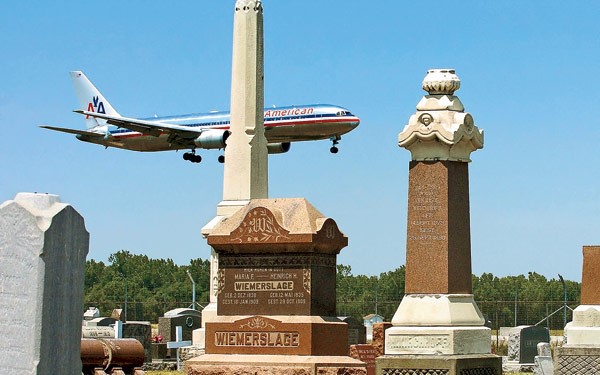Sacred defense
The sacred as defense against eminent domain
As has happened in many eminent domain cases, sacred ground became a battle ground of resistance to eminent domain. In Celilo Falls (Oregon) it was sacred Native American fishing grounds. At the Lake Buchanan (Texas) and the Norris Dam (Tennessee) sites, cemeteries factored in negative memories of the taking of land for new development. In Bensenville, two cemeteries occupied the land standing in the way of the O’Hare runway expansion.
Efforts to save St. Johannes Cemetery started in 2001 when Mayor Daley first announced the modernization plan. The disruption of sacred land was at the center of the resistance. St. John’s[1] congregation member, Reverend Michael Kirchhoff, was among the leaders in the opposition. He declared “We would accept no amount of money…. This is sacred land, not to be bartered away.”[2] Rev. Kirchhoff, who had a great-great-grandfather and other family members buried in the cemetery continued, “[i]n 1849 when the first burial took place, there was this sense of committing somebody to God’s care for eternity.”[3]
Within the State of Illinois and City of Chicago, a number of laws typically can provide the legal basis to preserve a cemetery or make relocation of bodies prohibitively expensive. The Illinois Human Skeletal Remains Protection Act, the Illinois Archaeological and Paleontological Resources Protection Act, the Religious Freedom Restoration Act, as well as provisions of the Illinois Municipal Code all have provisions protecting cemeteries.[4] However, with the passage of the 2003 O’Hare Modernization Act other laws were amended. For example the Religious Freedom Restoration Act gained a section stating that “Nothing in this Act limits the authority of the City of Chicago to exercise its power… for the purpose of the relocation of a cemetery or the graves located there.”[5]
Despite the slim legal odds, St. John’s United Church of Christ filed a suit against the relocation of the 160-year old St. Johannes Cemetery which it owned. The church lost its state and federal lawsuits, allowing Chicago to move the cemetery in 2011. St. John’s United Church ultimately agreed to accept a $1.3 million settlement for the land. Through the settlement, a total of 1,494 bodies were relocated to other cemeteries. O’Hare runway 10-Center/28-Center now lies over the former cemetery site. [6] The second cemetery, Resthaven Cemetery, was ultimately not moved. It now is nestled in between the FedEx Shipping Center and the Globe Air Cargo building within the O’Hare boundaries.

[1] What had been St. Johannes church changed its name to St. John’s, while the cemetery retained its original name.
[2] Geoffrey Johnson, “Dead Reckoning,” Chicago Magazine. October 5, 2009.http://www.chicagomag.com/Chicago-Magazine/October-2009/OHare-Expansion-Stalled-by-St-Johannes-Cemetery/. Accessed March 12, 2016.
[3] Johnson.
[4] Michael Trinkley, Debi Hacker, and Nicole Southerland, Removal of Four Burials from St. Johannes Cemetery, Bensenville, Illinois. Columbia, SC: Chicora Foundation, 2009, p. i.; Joravsky.
[5] Joravsky.
[6] Christopher Placek, “Dispute over cemetery land for runway comes to an end.” Daily Herald. December 28, 2012. http://www.dailyherald.com/article/20121228/news/712289857/
[7] George Thompson, Chicago Tribune Photograph in Geoffrey Johnson, “Dead Reckoning,” Chicago Magazine. October 5, 2009. http://www.chicagomag.com/Chicago-Magazine/October-2009/OHare-Expansion-Stalled-by-St-Johannes-Cemetery/. Accessed March 12, 2016.

